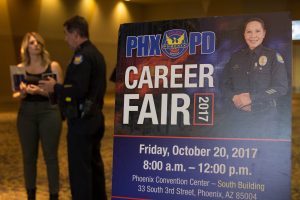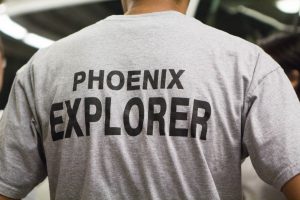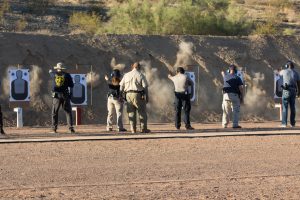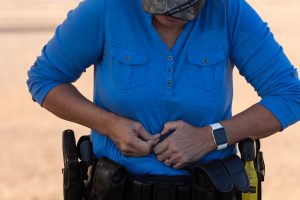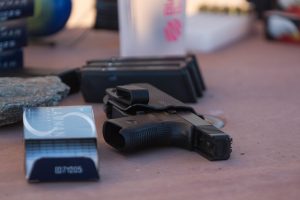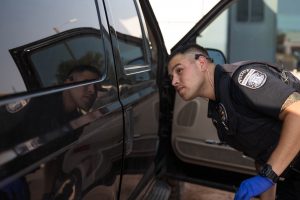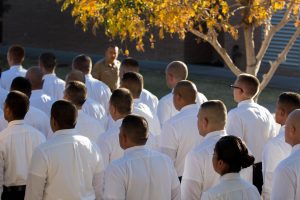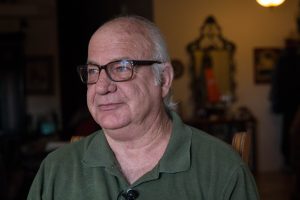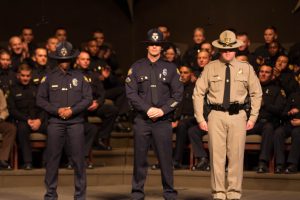- Slug: BC-CNS-LAW ENFORCEMENT DIVERSITY,2700
- Video available here
- Photos available (thumbnails, captions below)
- Map available (embed codes below)
(EDITOR’S NOTE: THIS IS THE FIRST OF A FOUR-PART SERIES. WE WILL PUSH THE REMAINING STORIES TO THE CLIENT SITE AS THEY BECOME AVAILABLE FOR CLIENT PUBLICATION. QUESTIONS? PLEASE CONTACT CHRISTINA LEONARD AT CHRISTINA.LEONARD@ASU.EDU.)
By ADRIENNE ST. CLAIR and JASMINE SPEARING-BOWEN
Cronkite News
WINSLOW – Despite national calls for more diverse law enforcement agencies, very few, if any, Arizona police departments reflect the demographics of the communities they serve – though diversity is not always their top priority.
Experts in Arizona and across the country say that while agencies should strive to mirror their jurisdictions, it is more important to focus on building a police force of well-trained, capable officers – regardless of race, ethnicity or gender – who can build strong relationships with their communities.
“In and of itself, just having more Hispanic officers or more female officers or more black officers won’t increase a positive relationship with those communities,” said Kevin Robinson, retired assistant chief of Phoenix Police Department’s patrol division. “You still have to go out and develop that relationship.”
But recent high-profile police shootings like that of Michael Brown, an unarmed black teenager shot by a white officer in Ferguson, Missouri, in 2014, have raised concerns about how officers treat communities of color across the U.S. and whether police departments should strive harder to increase diversity.
At the end of 2014, President Barack Obama established a Task Force on 21st Century Policing to address the increasing tensions after the shootings in Ferguson and elsewhere across the nation. Obama appointed former East Palo Alto, California, Police Chief Ronald Davis as executive director.
“Ferguson did not change the narrative, it revealed it,” Davis said. “It simply highlighted that which we’ve already known for many years, about the strained relationship between police and communities of color.”
South Phoenix resident Vicky Daviss-Mitchell said diversity in police departments would improve relationships. She said officers threw her nephew to the ground when he “didn’t answer the question right” after the officers approached him while he walked down the street.
“Say you were in a community that was predominantly African-American, you need African-American policemen. Or if it’s a mixed community, you need that particular police department to fit in with the community that you’re in,” Daviss-Mitchell said. “I think it would help.”
Christopher Reeves, who is part of a Phoenix Block Watch group, agreed.
“I grew up with a military background and from what I’ve known from my background and how I’ve grown up seeing the cops, anyone of authority has been white. And they like to hold that over you,” Reeves said. “Having more of a mixed culture in that area of the government so to speak, I feel it would be better for the youth so they can aspire to become a cop.”
Cronkite News requested records from 105 of 111 Arizona law enforcement agencies, asking for demographic information by sex, age and race of all full-time sworn officers over the past 10 years. Only 42 of 105 departments responded. For comparison, Cronkite News used 2013 data from the U.S. Bureau of Justice Statistics, which collected a demographic sampling of 37 Arizona police departments statewide.
The 2013 data included 9,574 Arizona officers. More than 75 percent were white, nearly 17 percent were Hispanic and just 3.1 percent were black.
Of the data that could be compared, little fluctuation occurred in the numbers for Native American and Asian officers. More than half of the departments that responded showed no change in black officers. The department in Sierra Vista showed the biggest increase in black officer hires.
Latino officers, however, increased in at least half of the departments, with the Mohave County Sheriff’s Office increasing the most by percentage, followed by Peoria. The Phoenix Police Department, which has 2,916 officers, is now 18 percent Latino, a slight increase from 2013.
In the past few years, Arizona police departments have struggled with funding and hiring freezes, which may have contributed to the lack of fluctuation in staffing. For example, the Phoenix Police Department lifted a hiring freeze in 2015 that began in 2011.
“We have recent evidence to suggest that simply changing the demographic of the police force, although it offers some benefit, is not going to fundamentally change all of the issues and problems with public perceptions,” ASU Criminology Professor Michael Scott said. “Much still depends on how the police behave.”
In Winslow, the police department is more diverse than most: With 23 sworn law enforcement staff, 13 are white, five are Native American, four are Hispanic and one is black.
For a town of just under 10,000 people, the Winslow Police Department is “really pretty well balanced with the town,” said Pete Henderson, a spokesman for the Winslow NAACP.
“We continue to recruit qualified people of all genders, races and cultural backgrounds,” said Winslow Police Chief Dan Brown, who has been in his position less than six months.
But even with its diversity, a controversial shooting last year strained relationships between officers, community members and the neighboring Navajo Nation. After responding to multiple calls about someone shoplifting at a local Circle K, a white officer shot and killed a 27-year-old Native American.
According to the Maricopa County Attorney’s Office, Officer Austin Shipley shot Loreal Tsingine when she refused to drop a pair of scissors as she came toward him. Shipley fired five times.
“A lot of folks were yelling, saying it was discrimination that he shot her,” said Henderson, who became a member of the local NAACP after the shooting. He’s part of a citizen liaison committee, which was created to address residents’ distrust and concerns.
Shipley resigned. In a statement, Maricopa County Attorney Bill Montgomery’s office said it “found no evidence of criminal conduct on the part of Officer Shipley.”
Henderson said the Winslow NAACP “took a real hard look” at the shooting and found no evidence of discrimination, but the group instead concluded Shipley shouldn’t have been a police officer in the first place.
“He would have shot anybody because he was poorly trained. He’d had a lot of discipline issues that were overlooked,” Henderson said. “It was more he had … like a Rambo kind of attitude.”
Brown, the police chief, said the profession is being demonized because of the actions of a small percentage of cops who “need to go away and go away quickly.”
“The large majority, the over 800,000 men and women that do this job across our country every day, they do it because they believe it’s a calling,” he said. “They believe that that’s the right thing to do, and you can’t take that away from them.”
Lisa Fisher, a Phoenix Police Department canine handler who has been with the department for 10 years, said she has worked with bad police officers, but she has overwhelmingly worked with good people who want to make their community better.
“I honestly think it’s just a perception. Yeah, there’s injustices that happen, and yes, there are corrupt police officers absolutely. But there are also corrupt doctors and nurses and teachers and garbage collectors,” Fisher said. “We just get a lot more press because people love to hate us, and they think we abuse our power all the time.”
In Window Rock, a town that serves as the capital of the Navajo Nation, Lt. Terry John of the Window Rock police said, “I think we’re pretty much trusted by the community.”
“What’s important is we hire qualified officers,” he said, adding that qualifications and attitude are the most important things. He wouldn’t be concerned if his force was mostly white, as long as the officers followed the Navajo Nation mission statement.
“The mission of the Navajo Nation Division of Public Safety is to show professional services through protection, prevention, accountability and innovation in the best interest of the Navajo Nation,” John said.
Mark Nipp, the police chief in Globe, said race doesn’t factor into his hiring, either.
“I don’t look at what an officer’s race is when we’re looking to make a hiring decision. I don’t care,” Nipp said. “We’re just picking the best candidate. We’re not targeting diversity as a goal, it’s just something that happens because we’re picking good candidates.”
“I think it’s more of just a symbiotic kind of relationship with the department and the community that we just, we fit in, you know?” he said.
Building such symbiotic relationships as Nipp described have become more difficult after shootings such as Michael Brown in Ferguson and Tsingine in Winslow.
“The biggest barrier that we have right now is lack of interest overall in law enforcement in America,” Winslow’s Brown said. “Bad press kills our profession, and my greatest fear is, where are we going to be 20 years from now?”
The increased use of technology – with residents and cell phones or police officers with body cameras – also has expanded the awareness of officer behavior – and misbehavior.
“One of the biggest problems law enforcement is facing is the technology that is allowing things that occur in real time to be posted right away and now everybody sees it,” said Robinson, the former Phoenix police assistant chief, who is black.
“People can’t see themselves being a part of an organization that has a reputation of – or there’s actual evidence of – them treating someone who looks like them in an extremely poor fashion, unprofessionally, and in some cases, illegally,” he said.
Jack Lane, executive director of the Arizona Peace Officer Standards and Training Board, said the public should be critical of their law enforcement agencies. The problem, he added, is that people can post videos without any context and make judgments about an arrest or a confrontation without knowing all the details.
“What they don’t know is what led up to (the arrest),” Lane said.
Officers and experts across the country also say technology presents a challenge to building relationships and can distort reality. But Police Chief Thomas Manger of Montgomery County, Maryland, said body cameras can inform the public in a good way.
“I’ll tell you what people are seeing. Just how challenging this job is. Just how tough a job it is to be a police officer,” said Manger, who has received national recognition for his work in immigration and community leadership.
According to an October 2016 report by the U.S. Department of Justice and the Equal Employment Opportunity Commission, “law enforcement agencies of all sizes have not always been successful in recruiting and attracting a pool of applicants that reflects the communities they serve” in spite of various efforts put forth by those agencies.
The report listed three major barriers to diverse recruitment that include strained relations and lack of trust between underrepresented communities and law enforcement, a potentially poor reputation of a law enforcement agency and lack of awareness within minority groups of available law enforcement opportunities.
But Robinson said he can understand people not wanting to become police officers right now.
“I would probably think twice about truly wanting to be a police officer because it’s negative,” Robinson said. “Because what you see is … that it’s a tough way to go, whether the officers are right, wrong or indifferent, they’re still in a really tough position.”
Davis, who is black, said law enforcement should give up on the idea of “blue culture” that has been part of policing for decades, because recruits want to see that an organization values diversity and experience.
“If you’re telling me I have to give up my culture to become a cop, somehow I gotta now become ‘blue,’ then the value of diversity … has been removed because we’re still not going to learn from my culture,” he said. “We’re not going to learn how to engage a community of my culture or any other culture.”
Alvaro Reyna, 19, faced resistance initially from his father when he joined the Phoenix Police Department Law Enforcement Explorer program, which helps youth and young adults become familiar with policing. Reyna said his father had a bad experience with the police when he immigrated to the U.S.
“When he found out about the program I wanted to join, he wasn’t furious but more, like, worried that I might end up with those abusive officers at the time that he was dealing with,” he said.
Reyna, a student at Glendale Community College, is a lieutenant in the program. It wasn’t until his graduation that his father said, “This is what I want you to do.”
Those involved in recruiting and hiring said they see fewer police recruits.
Corey Hanson, who until recently was the only person tasked with recruiting for the Arizona Department of Public Safety, said when he first started 20 years ago, hundreds of people would show up to take the test. Now he sometimes sees as few as 20.
“If I’m going to hire 50, I don’t want to hire the 50 people that passed everything. I want to hire the best 50 out of 250 people that passed everything. But the way it is now, if you make it through our process, you’re going to get offered a job,” he said. “We’re not going to lower our standards – with that comes some struggles. We lose a lot of people in the qualification process.”
Hanson recently transitioned to a position in the criminal investigations unit, but he said the DPS is currently only hiring a fraction of the people who try out.
“We make our numbers for the most part, but it’s difficult, we’re hiring less than 1 percent of everyone who applies. It’s a pretty rigid process and not everybody who wants to do this job can. It’s just the truth of the matter,” Hanson said.
Lane, who has been the director at AZ POST for two years, said there are “a lot” of certification requirements. Recruits must submit to a complete background check, which includes interviews of people in their life and strict minimum standards for past drug use. Recruits also must pass a polygraph test, a 21-22 week academy and a seven- to eight-hour exam.
The process is rigorous, but he said he thinks agencies “are getting better quality of people.” But he also said hiring is difficult for all Arizona agencies right now.
James Molesa, the chief deputy for the Navajo County Sheriff’s Office, said diversity would be a priority for him in Navajo County, but strict hiring standards make it difficult, especially for a department in rural Arizona. He currently has six openings for sworn officers, but out of 22 applicants, he only got three possibilities.
“I would love to have a workforce that mirrors the population that I serve, but I don’t set the rules on who gets hired and who doesn’t. The state of Arizona does that,” he said. “So I have to find men and women who live in my geographical area that can pass the AZ POST guidelines.”
Molesa tried to address this problem and “protect the taxpayers of Navajo County” four years ago by introducing a program that promises to pay for new recruits to attend the police academy if they commit to two and a half years of work upon certification, or at least a plan for repayment.
“Otherwise I literally end up being the triple-A team for the Valley,” he said, referring to the White Mountain area.
In addition to barriers with recruiting and hiring, Arizona officers have to deal with immigration – what Robinson called “the elephant in the room.”
Arizona agencies have been at the center of immigration enforcement for decades, with former Maricopa County Sheriff Joe Arpaio fighting for strict immigration enforcement. A judge eventually convicted Arpaio of contempt of court for refusing to stop the racial profiling of immigrants. President Donald Trump later pardoned Arpaio.
Arizona also passed the controversial Senate Bill 1070 legislation, in which officers were instructed to determine immigration status on “reasonable suspicion” during a routine stop.
Edder Diaz Martinez, the ASU student and immigrant rights activist, said that in the community where he grew up in Phoenix, Maricopa County sheriff SUVs often would drive around his neighborhood.
“It was a clear intimidation tactic,” he said. A way to assert their authority. And he said that it still seems that Hispanics like him are “being targeted for the color of their skin.”
The DOJ/EEOC’s 2016 report also concluded that “law enforcement agencies fulfill a fundamental role in our society, and in many communities, individual police officers are often the public face of local government. It therefore is critical that our nation’s law enforcement agencies broadly reflect the diversity of the communities they serve.”
Alejandro Barron, an officer with the Winslow Police Department, said he frequently plays basketball with some of the local kids in a predominantly Hispanic neighborhood to earn their trust.
“I’d like to give them the impression that we’re the good guys, so when they grow up they don’t make wrong choices,” he said.
Cronkite News reporter Tynin Fries contributed to this report.
^__=
MAP EMBED:
<iframe src=”https://www.google.com/maps/d/embed?mid=1eZb1Us-xlcTKZr5JtK9qPKTIK28e-cKy” width=”640″ height=”480″></iframe>
^__=
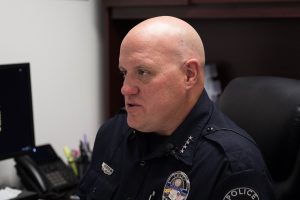

Pete Henderson, a spokesman for the Winslow NAACP, says the department is well balanced. (Photo by Tynin Fries/Cronkite News)
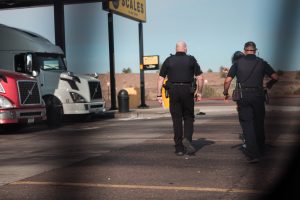
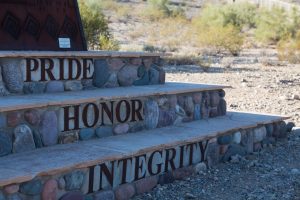
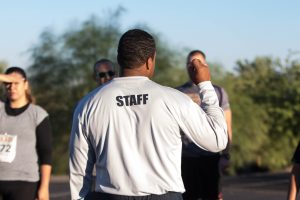
The sampling of Arizona police agencies represented in 2013 data from the U.S. Department of Justice indicated the departments had 9,574 officers. More than 75 percent were white. (Photo by Jasmine Spearing-Bowen)
